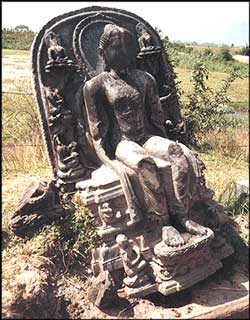| |
 After
delivering his first and second discourses at Sarnath the
Buddha returned to Bodh Gaya where he preached to, converted
and ordained the three Kassapa brothers and their one thousand
followers. Then accompanied by this large group of new monks
he went to Gaya, where he preached the Fire Sermon, and
then headed for Rajgir to meet King Bimbasara. Hearing this
the king and his entourage came out of the city to welcome
the Buddha and the two great men met at the village of Lativana,
the Palm Grove, now called Jethian. In the seventh century
Jethian became famous as the seat of Jayasena, the greatest
saint of the time. The Chinese pilgrim Hiuen Tsiang spent
two years here studying with Jayasena. After
delivering his first and second discourses at Sarnath the
Buddha returned to Bodh Gaya where he preached to, converted
and ordained the three Kassapa brothers and their one thousand
followers. Then accompanied by this large group of new monks
he went to Gaya, where he preached the Fire Sermon, and
then headed for Rajgir to meet King Bimbasara. Hearing this
the king and his entourage came out of the city to welcome
the Buddha and the two great men met at the village of Lativana,
the Palm Grove, now called Jethian. In the seventh century
Jethian became famous as the seat of Jayasena, the greatest
saint of the time. The Chinese pilgrim Hiuen Tsiang spent
two years here studying with Jayasena.
Beside
the road leading to Jethian village from the south is a
large mound with a tank next to it. This is the remains
of the stupa later built over the Supatittha Cetiya, the
place where the Buddha stayed while at Jethian. Besides
this mound is a large and impressive statue of the Buddha.
A little further on at Saravoday Vidyalaya, the local school,
is a statue of Padmapani and another of the Buddha found
in the a rea. rea.
About
3 kilometres away on the north side of Chandu Hill is a
large cave called Rajpind. This must be one of the caves
mentioned in the Tipitaka as being in the vicinity of Rajgir
but exactly which on can no longer be determined. Numerous
pigeons nest in its dark interior so perhaps it is the Kapotakandara,
the Pigeons Grotto, where Sariputta sometimes used to stay.
To get to Jethian turn west just before the Gaya - Rajgir
road enters the mountains at Rajgir. Jethian is difficult
to get to but well worth the effort.
|